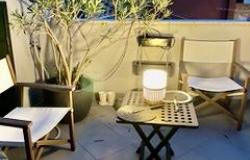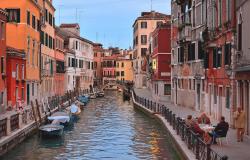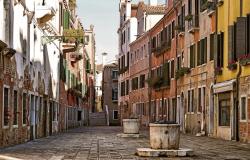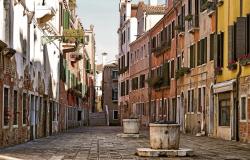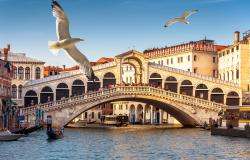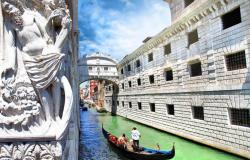Mention Venetian glass and you might first recall the clutter of kitsch ornaments your Great Aunt Dorothy used to proudly display on her mantelpiece. But there is much more to this craft than the creation of peacock-blue gondolas or gaudy pink flamenco dancers. Venetian glass has long been famous throughout the world, and the small island of Murano, only a mile from the centre of Venice, became the world centre of the craft after it moved to the island from Venice at the end of the 13th century. Some say this move was for safety reasons after many fires had destroyed the city’s wooden houses, while others consider that the new location made it easier to closely guard the secret skills of the trade.
The techniques of glassmaking were carried to the Venetian Lagoon by Syrian craftsmen and early traders from the East centuries before.
Glassmaking flourished under the Romans, and by the time of the move to Murano it had become an important industry, with the Venetian Lagoon as its centre. The secrets and skills of the glassmakers were so prized that it was a treachery punishable by mutilation or death for a skilled artisan to try and leave the Venetian state. The profession enjoyed huge respect and privileges, such as the right to bear swords, marry into noble families and have immunity from prosecution under the strict laws of the Venetian state. Murano held a monopoly on mirror and glassmaking until the 17th century, by which time the secrets of the trade had leaked out and workshops appeared in Bohemia, France and England.
The ancient skills have changed very little over the years and can be seen all over the island today in numerous workshops. Some of these
are sophisticated companies that have been established for generations and which still send finely-crafted glass ornaments to smart shops all over the world. Names like Barovier have been linked to the art of glassmaking for over 500 years, and the showroom of Barovier & Toso on Murano’s Grand Canal is a testament to the skills of the craft.
A tough apprenticeship
Glassblowers typically work through an apprenticeship of over 10 years before they are accepted as craftsmen. Many, like the contemporary
master of glass, Gianni Seguso, learnt these skills from their fathers when only children, following a tradition going back centuries.
Seguso achieved the revered title ‘Maestro Vetraio’ (Master Glassblower) at the age of just 18. What distinguishes such masters of the art is their tireless experimentation with different types of glass, and the classic Italian flair for producing timeless classical designs.
Some of the techniques glassmakers have at their fingertips are quite remarkable. These include decorating glass with threads of gold
(aventurine), milk glass (lattimo), intricate filigree (reticelli), enamelled glass (alto), or creating spectacular effects by adding particles of copper or other metals to the molten glass. If you want to see some of the finest examples of the glassmaker’s craft, visit the Museo Vetrario in Murano, where you will find Adriatic glass dating back to the 1st century BC, as well as glass made locally over the centuries, including the famous 15th-century Barovier wedding cup.
The island of glass
Still dubbed ‘the island of glass’, there are about 20 large industrial glassmakers as well as over 60 smaller ‘artisan’ glass factories on Murano. The smaller ones are often housed in ancient buildings and are currently experiencing difficulties complying with EC environmental directives so that several have been forced to close. The metal oxides and arsenic that have historically been the toxic ingredients of Murano glass are finally threatening the craft’s survival.
The process
Meanwhile, a visit to any of the glass workshops on Murano will give you an insight into how this craft has been continuing over the
centuries. As if in an alchemist’s workshop of legend, the glass is made in huge ovens the day before by heating sand and silica, together
with a soda and lime mixture, to temperatures in excess of 1,400 degrees C. This mixture melts and is fused with other additives including nitrate and arsenic, as well as metal oxides, if the glass is to be coloured. The heat is reduced to around 700 degrees C to create a
workable viscosity, and a small lump of molten glass is picked up on the end of a hollow tube. Often this is turned in a wooden mould to
establish the basic shape before being skilfully blown to produce the enlarged hollow form. Another essential tool is a kind of pincers (borsella) to mould and trim the exterior surfaces and manipulate its outer shape. All this is done with remarkable speed, sometimes re-heating the object to keep the glass workable. Finally, the work is placed in a cooling gallery before it can be handled.
The smaller workshops are chiefly centred on the Fondamenta dei Vetrai, and many unashamedly perform their craft for the benefit of the tourists who are regularly shuttled to the island. Sadly, many examples of the workmanship you will find here are of questionable taste.
Sometimes the demonstrations, which begin at regular intervals, result in the creation of intricate glass birds or fish. An apparently abstract shape is suddenly inverted, elongated, and with the deft clip of the pincers and a subtle flourish, a familiar animate shape is revealed, to the surprise and delight of the enthusiastic tourists.


